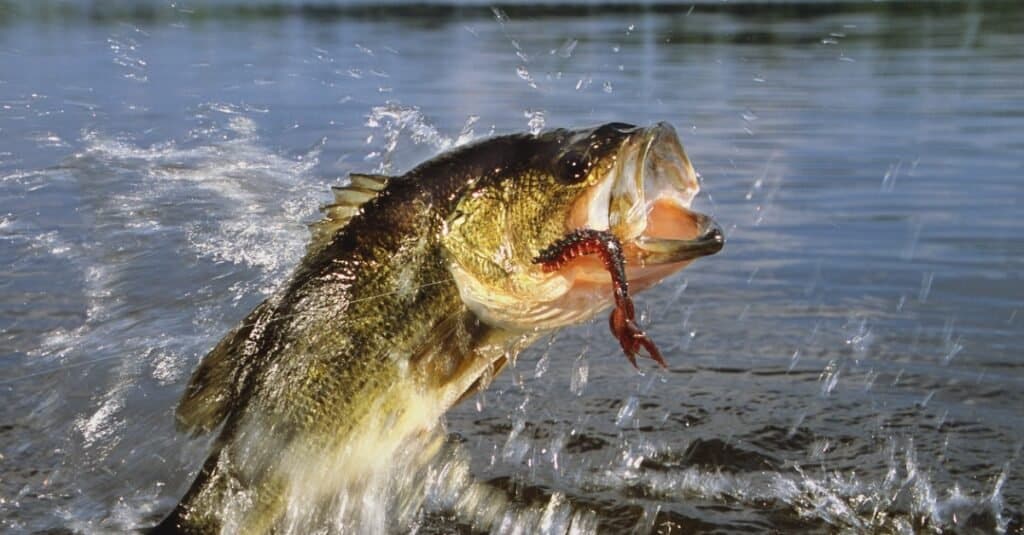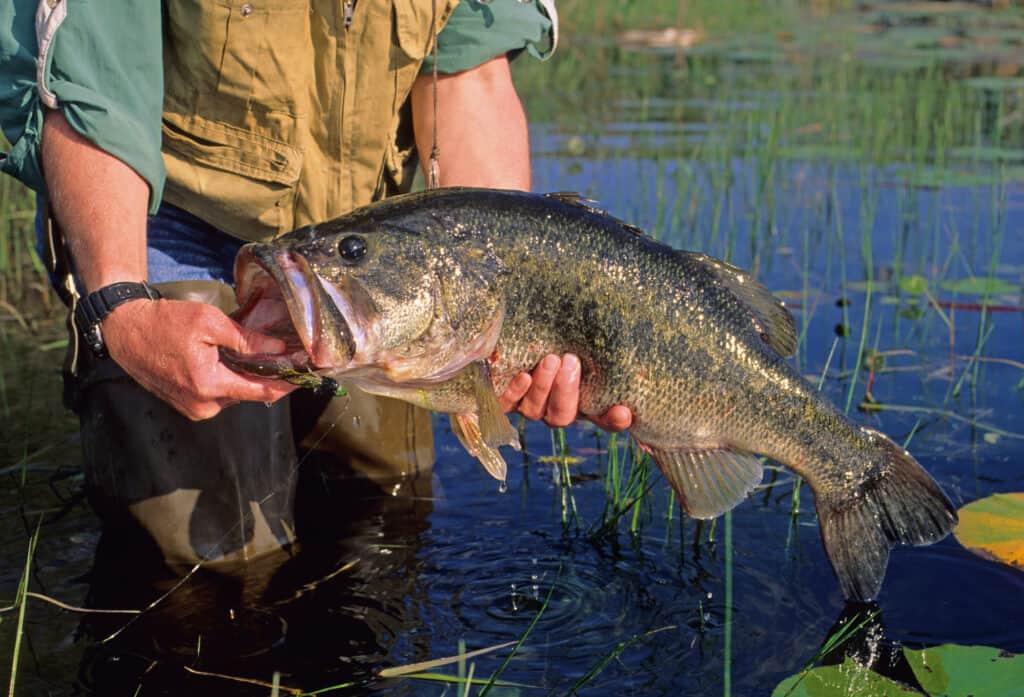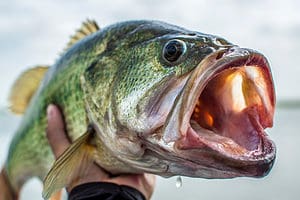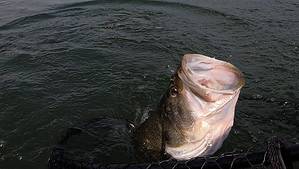While bass fishing in the United States encompasses many unique species of bass, the largemouth is the most impressive and sought-after due to its enormous size and feisty nature. Fortunately, most states’ governmental wildlife authorities record and track local record-breaking catches. This time, we’ll be taking an in-depth look at Missouri’s largest largemouth bass, where it was caught, and how it measures up to the current world record!
Largemouth Bass Facts
The largemouth bass is one of 13 species that make up the Micropterus (Latin for “small fin”) genus. These species are better known collectively as the black basses. While most black basses range in size from around 12 to 24 inches long, the largemouth is the longest and heaviest on average. Adult specimens can reach close to 3 feet long and weigh more than 20 pounds. In fact, the largemouth isn’t just the largest species in its genus–it’s also the largest member of its entire family, Centrarchidae, which consists of 38 unique species.
Like most other black basses, the largemouth has a rich, deep greenish body color with dark brown patterning along its sides. It has a long, laterally compressed body with thin fins supported by long, narrow, bony rays. The underside of its body fades from green to pale gray or white. The species is prominently sexually dimorphic. Females are larger than males, as they must carry large amounts of eggs during breeding seasons.
While the largemouth bass is native to the United States, it has since been introduced to many other areas of the world, like Japan and parts of Europe’s Iberian Peninsula. As a hardy and adaptable species, it thrives in many freshwater habitats. However, it prefers warm, slow-moving, clear waters with ample aquatic vegetation. Largemouths spawn in the spring when water temperatures reach at least 60F. They mature quickly, reaching sexual maturity at around 1 year old.
Largemouth basses tend to hide amongst dense vegetation to stalk their various prey, including small invertebrates like worms and snails, small fish like shad and shiners, and amphibians like salamanders and frogs.

The largest bigmouth bass ever caught in Missouri was captured in 1961.
©iStock.com/stammphoto
Largemouth Bass Fishing: A Brief History
Interestingly, largemouth bass fishing has an extensive history dating back to the late 1800s. With the development of the steam engine and more extensive railways in the US came rapid expansion westward. Across the country, tank ponds supplied steam engines with water. These tank ponds were ideal for storing various species of game fish. Many unique species of freshwater fish tolerated being transported to these tank ponds, though the largemouth bass was among the hardiest (and largest) of these species.
As the largemouth bass began to pop up in tank ponds all over the United States, largemouth bass fishing also developed as a hobby. Fly fishing was one of the first methods American fishermen used widely. Notably, they adapted this method from existing tactics used to catch other North American fish of a similar size, like salmon and trout.
By the 1940s and ‘50s, largemouth bass fishing continued growing in popularity. A post-war fishing boom occurred around this time as the U.S. Department of Agriculture began to assist farmers with stocking and maintaining the many established tank ponds across the country. Floating wooden lures became a popular method at this time. Later, plastic worm lures became the norm around the late 1950s, as they were inexpensive and fast to produce.
In 1967, the B.A.S.S. Federation held its first tournament designed for largemouth bass fishers. The Bassmaster Classic followed in 1971, with many other organizations following suit, holding their own competitions for fishers hoping to hook a record-breaking bass. Today, fishers use many unique methods to catch largemouth basses, such as live baits and moving swimbaits. Catch-and-release fishing is ideal in the United States to prevent breeding populations from overfishing. The species isn’t commonly eaten in the U.S. due to its unusual taste and rather mushy meat.
How Big Do Largemouth Bass Get?
As mentioned prior, the largemouth bass is perhaps most impressive for its massive size and heavy build. As the largest member of both its genus and entire family, it dwarfs the other black basses. On average, an adult largemouth bass can reach anywhere from 16 to 24 inches long. However, some specimens exceed this length, with especially large examples nearing 30 inches long.
In addition to being a rather lengthy fish, the largemouth is also incredibly muscular and heavy. Typical sexually mature adults weigh around 12 pounds, though many exceed 20 pounds. They mature quickly, often reaching their maximum size within their first year or two of life. Even as juveniles, largemouth basses are capable of taking down large prey like fish and amphibians.
This hefty size and muscular build contribute significantly to the largemouth bass’ trademark “fight,” which makes it a challenging and highly-regarded catch among experienced anglers. What’s more, the largemouth is so massive and powerful that it can eat prey around half the size of its own body with ease!

Largemouth bass can thrive in a wide range of temperatures and water conditions.
©iStock.com/stammphoto
What Is The Largest Largemouth Bass Ever Caught In Missouri?
Now that we know more about the largemouth bass, its impressive size and strength, and why it’s such a prestigious catch, we can take a look at some of America’s–and the world’s–record-breaking specimens. This time, we’re looking at Missouri’s largest largemouth bass ever caught, and it’s a whopper!
Fortunately, the Missouri Department of Conservation tracks a wide range of state fishing records. The largest largemouth bass ever caught in Missouri was a 13-pound, 14-ounce specimen caught by angler Marvin Russell Bushong, of Gainesville, Missouri. What’s especially amazing about Bushong’s record, though, is that nobody has managed to break it for more than 60 years!
Yes, it turns out this accomplished angler caught Missouri’s record-breaking bass all the way back in 1961. He caught the fish at Branson, Missouri’s Bull Shoals Lake, which remains a popular tourist and fishing destination for both Missouri and Arkansas residents.
What Is The Largest Largemouth Bass Ever Caught?
Finally, we’ll take a look at how Missouri’s largest largemouth bass ever caught compares to the current world record. Although Marvin Russell Bushong’s record is incredible in its own right, it’s still around 8 pounds shy of the world’s heaviest specimen. On paper, though, two anglers actually share the world record: Manabu Kurita of Aichi, Japan, and George W. Perry of Rentz, Georgia. But why? Can two people even “share” a world record?
According to the International Game Fish Association, newly-established records must be at least 2 ounces larger than the previous record holder. While Perry’s catch came first back in 1932, it continues to share the record with Kurita’s fish caught in 2009. This is because Perry’s largemouth bass measured 22 pounds, 4 ounces. Meanwhile, Kurita’s challenger to the record weighed in at about 22 pounds, 5 ounces. This means Kurita’s bass only exceeded Perry’s catch by around one ounce.
As a result, Kurita and Perry share the record to this day, despite the two fish being around an ounce apart in size. Kurita caught his record-breaking bass at Japan’s Lake Biwa, while Perry caught his bass at Georgia’s Montgomery Lake. These two incredible specimens were caught more than 70 years apart. What’s more, their respective anglers caught them on opposite ends of the planet!
Today, Montgomery Lake, located in Telfair County, GA, is regarded as a historic fishing destination. A historic marker has been erected nearby in honor of Perry’s catch. Meanwhile, Japan’s Lake Biwa also remains a popular fishing spot. It is located in Kyoto’s Shiga Prefecture and boasts incredibly diverse fish and waterbird populations.
Where Is Missouri Located On The Map?
Bull Shoals Lake is located in the Ozark Mountains of northern Arkansas and southern Missouri. Missouri is located in the mid-west region of the United States. It is bordered by Nebraska to the northwest, Iowa to the north, Illinois to the east, Kentucky to the southeast, Tennesee and Arkansas to the south, Oklahoma to the southwest, and Kansas to the west.
The photo featured at the top of this post is © Pierre Rebollar/Shutterstock.com
Thank you for reading! Have some feedback for us? Contact the AZ Animals editorial team.






